Ever since you built your hydroponic system, you’ve kept your grow room tidy. You sweep and wipe down your workspace frequently.
But is that enough? How clean is your hydroponic equipment actually getting? Is it sanitary or sterile? What’s the difference anyway?
In this article and video, Ethan from our own grow room walks you through why keeping up on cleanliness is important, and gives you some suggestions on how to stay safe.
In this article, we’ll discuss the importance of keeping your grow operation clean, what the difference between sanitation and sterilization is, the materials and cleaning agents to use—and how to use them—as well as cleaning processes, frequency, and some critical dos and don’ts.
*The methods listed here are for hydroponic systems. Aquaponic growers should modify the materials and methods used to factor in fish and microbe health. To learn more about fish and aquaponic additives, see the section on Lethal Concentration 50 (LC50) in this post.
Why is cleanliness in your grow room important?
The number one benefit of a clean system is human health. If you don’t keep the environment clean, you’ll more than likely be harvesting produce that isn’t clean or healthy. It may even make your customers ill.
The second benefit is the health of your plants. If you don’t keep your grow room clean, you’re opening up pathways for disease and fungal pathogens.
The third reason that keeping things clean is so important is certifications and standards. Not only is it suggested, it is often required. Whether you are trying to be organically or otherwise certified, keep in mind that these usually have very detailed standards when it comes to sterilization and sanitation.
Check with the specific licensing board for your certification to make sure you’re doing everything correctly.
Cleanliness is clearly important for a growing operation, but which—sanitation or sterilization—is more so? Let’s discuss what that difference is, and how each should be handled.
How to sanitize and sterilize hydroponic systems
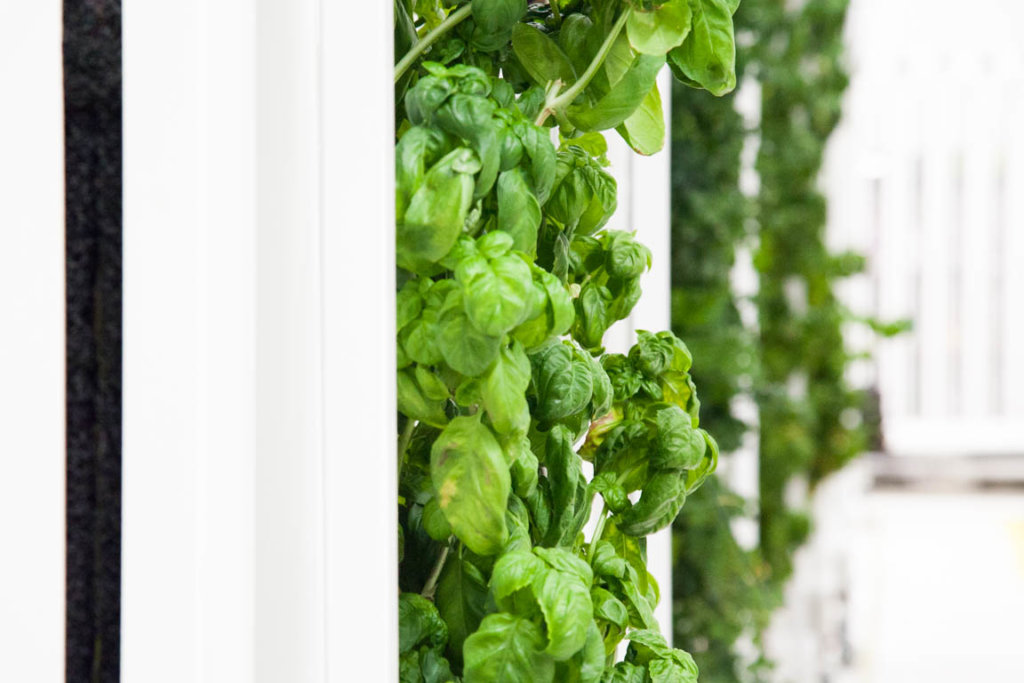
What exactly is the difference between sanitation and sterilization?
Sanitation is the general cleanliness of your grow room. This might include sweeping, removing dead plant material from the system, mopping up any spills or messes, cleaning out filters, scrubbing your IBC, and keeping your harvest and planting areas clean and well-prepped.
Sterilization kills microbial life, including bacteria or fungi that could cause disease in your plants.
But isn’t microbial life a good thing? Why kill microbes? To be clear, many microbes that live in the rhizosphere (the root zone) of plants are essential for nutrient uptake and protection against disease. While we want to sterilize media, tools, and system parts like irrigation lines, we don’t want sterile plants.
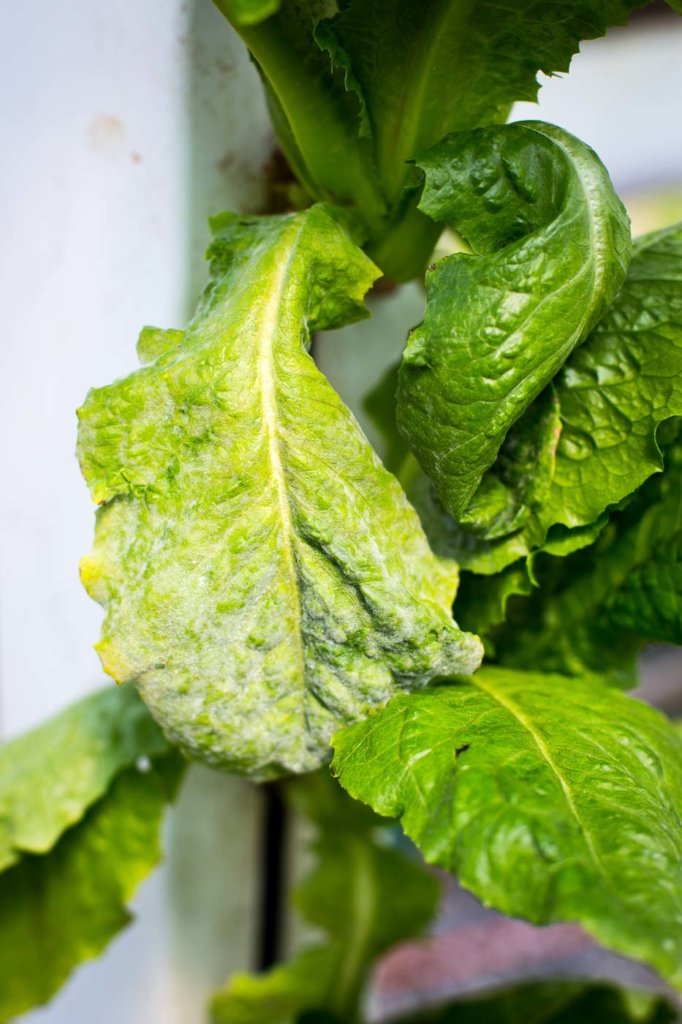
Sterilization helps to keep fungal spores like those of powdery mildew from spreading.
To keep from spreading disease and pests, growers should sanitize their grow room and equipment. For instance, if a grower harvests a lettuce head with powdery mildew, then uses the same clippers on 30 more heads, then he has spread powdery mildew spores to those 30 plants. If he had dunked the clippers in a bleach solution, then he might have avoided that.
Sterilizing is often achieved by using bleach, hydrogen peroxide, and antibacterial products like Lysol. These can be applied in sprays, dunks, or soaks; whatever it takes to kill off that microbial life.
You should use both sterilization and sanitation in order to make sure that your grow room is as clean as possible. Each is accomplished with different materials and processes, and you’ll want to know when to use which.
Materials
Tools
Growers need to keep several items around for cleaning purposes. Scrubby sponges and stiff brushes are great for getting surfaces scrubbed down. For places like reservoirs and other hard-to-reach areas, use a long-handled brush.
A couple of things that are sometimes overlooked but that are just as important to have are eye protection and gloves for when you are handling harsh chemicals. While human cleanliness is important, we don’t want you so clean that you get sick.
Other tools include scissors and clippers to help you remove that dead material from your plants.
Cleaning agents
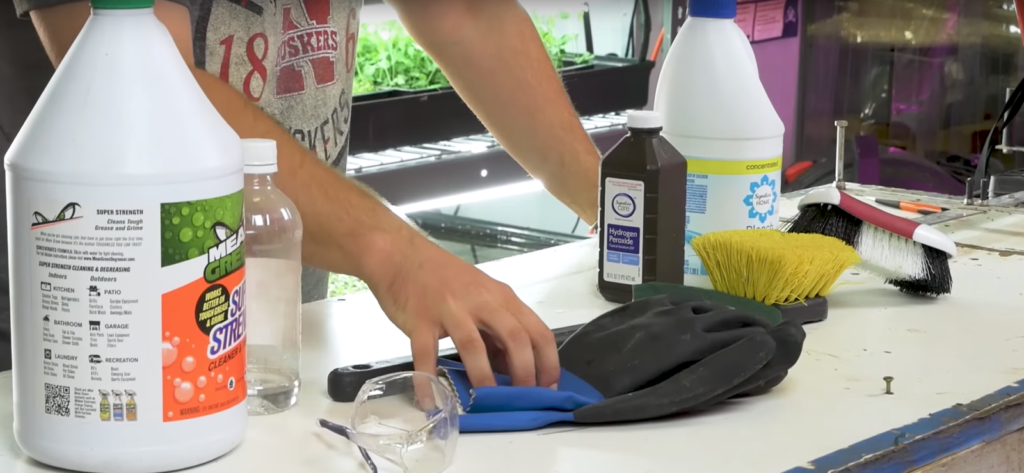
Bleach and hydrogen peroxide (bonus points for food grade!) are great agents for sterilization.
Degreasing agents, on the other hand, are more for general sanitation, which means that it’s just for cleaning up spills or messes. It won’t kill any microbes.
Another sanitation option for organic types is using vinegar.
There is one more tool used for sterilization that is not shown in the video. This is an ozone machine. Ozone can be pumped out into the air of your grow room. It will sterilize anything it comes into contact with. Unfortunately, that includes you; you cannot be around while an ozone machine is running. It is much safer for humans to use ozone to help sterilize your hydroponic solution by pumping it into your nutrient reservoir.
It is super important to note that there are toxic doses of these agents to the plants. Hopefully, you understand that you shouldn’t go dumping bleach or hydrogen peroxide into your reservoir all willy-nilly; if you want a good way to kill your plants, that’s it.
BUT, there is a safe amount of peroxide that you can add to your reservoir while you have plants in it. Bleach we do not recommend adding while you have plants in your system. Save that for sterilization and flushes between growing cycles.
Agents for sanitation probably shouldn’t ever be getting into your reservoir; it is more than likely that they’ll kill your plants. Use these around the area of your plants, just avoid getting them on the foliage.
So we’ve talked quite a bit about what to use, but how, where, and when should you use it?
Cleaning process
Start by sanitizing and sterilizing your room. Begin at the top, and work your way down; scrub walls and surfaces, sweep and mop floors etc. Keep your working areas tidy. The less mess you have, the less potential for plant disease you’ll also have.
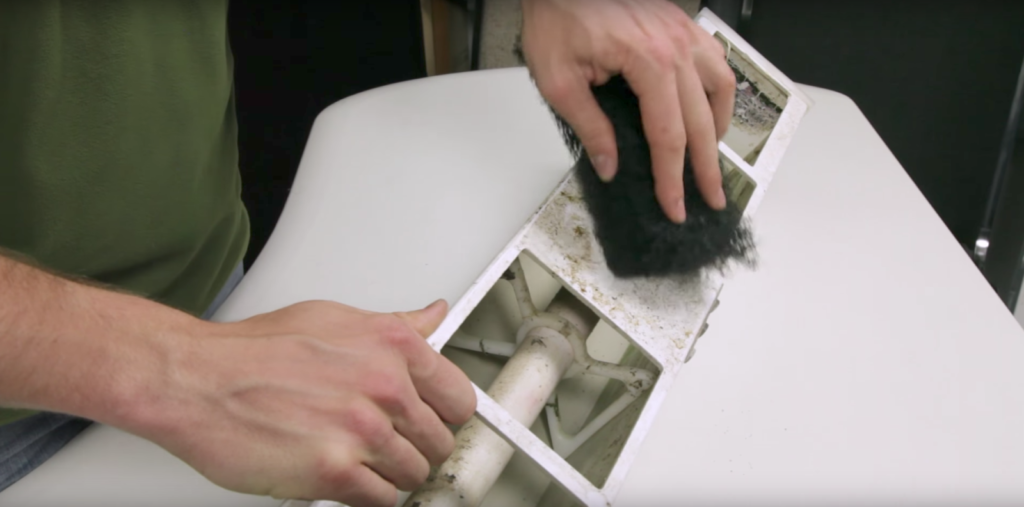
Smaller systems like Farm Walls need to be cleaned too; start by scrubbing the gutters.
Keep all equipment sanitized and sterilized including the components of your system and the tools you use. Even your scissors; if you don’t keep those clean, you’re opening up the possibility of infection every single time you cut a plant with them. Keeping equipment sterilized is the key to limiting the spread of disease.
In our vertical system, we like to blow out all of the lines to prevent clogs, vacuum out any drainage, and wipe or scrub down tower faces and gutters. For reservoirs, you’ll either want to scrub down the sides or use a pressure washer. If you don’t have a pressure washer, that long-handled brush will come in handy.
Once you’ve got it scrubbed down, you can always use bleach or peroxide to sterilize it. Make sure to flush it afterward, and fill it up with clean, fresh water to start new.
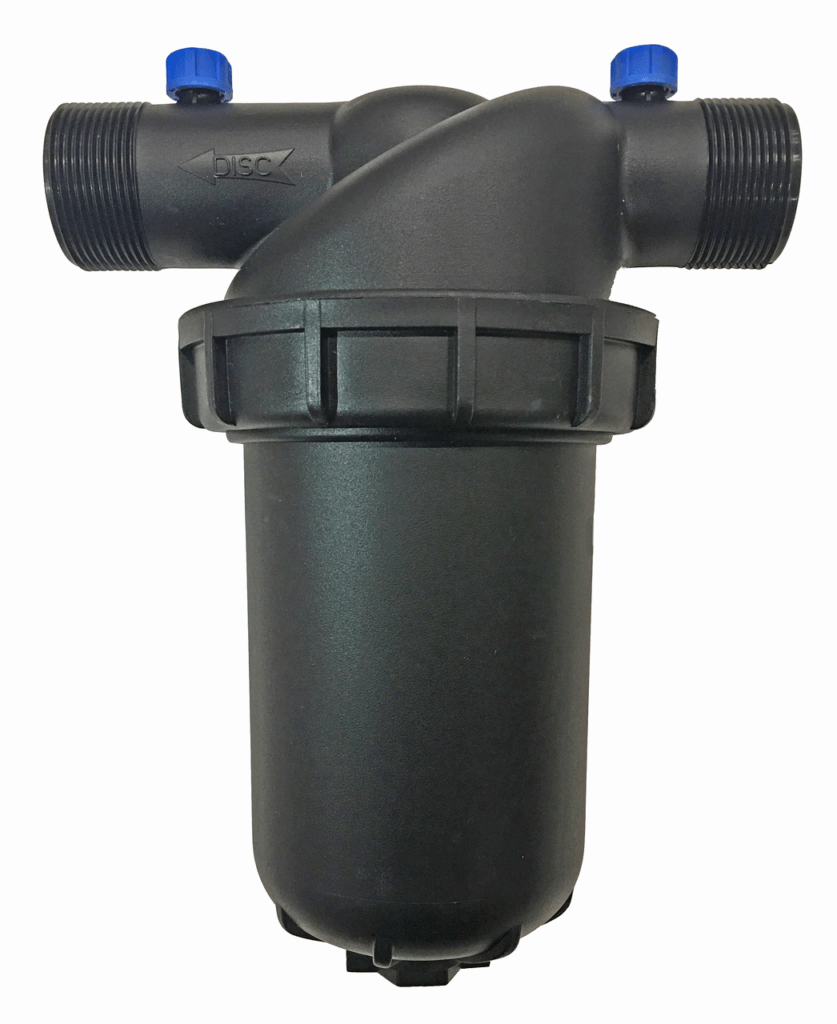 Filters also need to be cleaned; check your swirl filter if you’re using a larger system. This filter gets all of your large particulates and doesn’t need to be checked as often as your Y-filter.
Filters also need to be cleaned; check your swirl filter if you’re using a larger system. This filter gets all of your large particulates and doesn’t need to be checked as often as your Y-filter.
Y filters, something that a lot of smaller systems will have, need to be cleaned very regularly, though sterilization isn’t as important.
When it comes to growing media, remember to remove as many roots as you can. At some point, you’ll want to sterilize it with dilute bleach and with hydrogen peroxide. This can be done two ways:
- Put the solution into your reservoir and run it through the towers and the system*, or
- Get a flood table tray and dunk your media into the solution.
*If you’re using bleach, remember that you’ll need to flush the system before filling it.
Cleaning frequency
How frequently do you want to be sanitizing and sterilizing?
Usually, most people in a hobby market can get away with just cleaning when the system is visibly dirty. Remember that if you have a certification or license, you need to check with the licensing or certification boards for standards and a schedule.
Even if you’re not certified or licensed, we recommend that you keep up with some sort of cleaning schedule. Try to do it at least once a week, if not more frequently—this way you can prevent clogs and other mishaps. You’ll probably have spills and messes throughout the week anyway. Cleaning is a daily activity in the hydroponic world.
Now that we’ve gone through the basics of sanitation and sterilization, we need to discuss some safety dos and don’ts.
Dos and don’ts
Read the label
There are lethal doses of the cleaning agents that we have covered. This information and safety laws are included on the label, which should always be read before using any cleaning agent.
No super strengh solutions
Do not use super strength cleaners and degreasers on plants or dump them into your reservoirs—you will kill your plants. Some things, like hydrogen peroxide, can be used in hydroponic solutions with living plants, but it is crucial that you are careful in measuring the appropriate (very small) amounts. Vinegar can be used similarly; bleach, on the other hand, will kill your plants.
Put safety first
Always keep safety in mind; use your gloves and safety goggles or glasses to protect yourself from harmful chemicals. Often if they are harmful to plant life, they’re harmful to human life as well.
*If you are running ozone, keep in mind that it is toxic to humans. If you’re pumping ozone into the air, no one should be working in that area. It is safe to work around if and only if you are pumping it into a liquid, like your reservoir, and you’re not running it constantly.
Know your solution
Even familiar solutions can be hazardous. Food grade hydrogen peroxide, for instance, is much, much more concentrated than the stuff you usually get off the shelf. This means that it needs to be treated like a caustic substance until it is diluted in water.
Ready to start cleaning?
If you have a question or comment on something that we didn’t touch on in this blog, let us know and we will get that information to you!

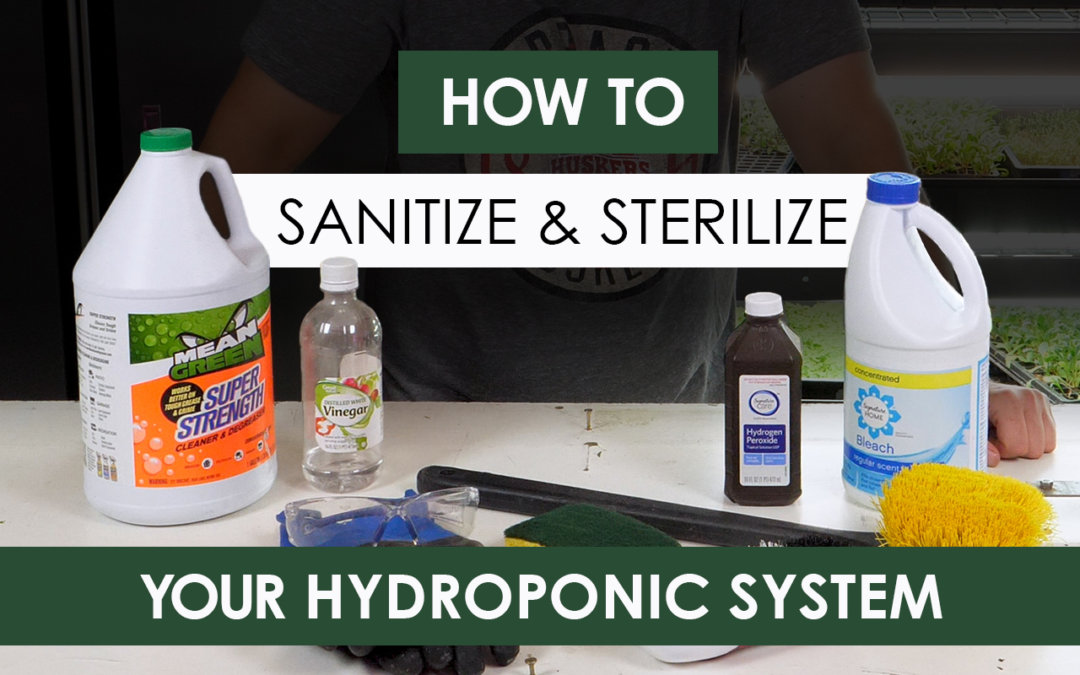

This is awesome guidance… and at a detailed level relevant to both the novice and experienced indoor grower. There is a bit more specifics that could be discussed depending on formfactor… towers, rafts, NFT, etc., but as an advocate of the CEA movement, I thank you for advancing the critical “backroom” aspects of maintenance.
Does anyone at Upstart have experience with this product?
http://www.ecologiccleansers.com/products/one-step/
We use it for our brewing equipment but unsure of impact in a tower system.
Thanks!
Hi
Thanks for the video.
I am growing micro greens in a flood and drain system.
I have been using Bleach solution (1000-1) to sterilize and sanitize.
I use this mix to clean my seedling trays and drench my growing media before seeding. I use hemp and biovelt material to grow my micros and once dunked in the solution they obviously retain the mixture going into the germination chamber.
Is this ok for the seeds to sprout and start in the germination chamber or should i rather use a mixture of water and hydrogen peroxide to dunk the media?
I do not add any bleach to my reservoir in the water bath of my germination chamber nor the reservoir of my grow out flood and drain system.
Please advise if on the above
Thanks for the help
Hi Rael,
The bleach dilution you are using (1000-1) is not worrisome, but peroxide is much safer in comparison.
Everyone has failed to mention delusion ratio of 35% H2O2 in respect to H2O. Is 10 mil’s per gallon a good ratio for clay medium and system flushing between grows? Awesome educational videos. Especially the disease and toxicity ones I’ve watched. Thanks for reliable information cuz YouTube can really be insane with bad info for ALOT of people that are taking themselves way to serious concerning what they call knowledge. Most should zip-it and go back to watching videos instead of relaying wrong information and infecting the channel which needs a good sanitizing and sterilization. Hard to watch without gloves and goggles on. Lol
If I am sanitizing Styrofoam floats after harvesting, do I also need to Sterilize them occasionally? Is power washing and using a commercial chlorine sanitizing agent enough?
Hi there! Sanitizing should be plenty.
I have an out side system that is tiered and the plants not have a lot of slim on the roots and are turning black on the strawberries but peppers and lettuce is good. There is a lot of algae on the bottom and sides. Can you help me flush out or start all over again ?
With 29% h2o2, what is the proper dilution rate for cleaning a 2nd hand tower garden? Wa told to run it for a few hours, but at what strength?